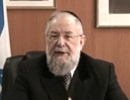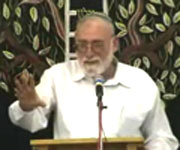Beit Midrash
- Torah Portion and Tanach
- Bamidbar
- Masei
- Sections
- Chemdat Yamim
- Parashat Hashavua
Homicide is never less than serious in Jewish law. But there is a fundamental difference between murder – deliberate killing – and manslaughter, accidental death. To kill someone not guilty of murder as an act of revenge for an accidental death is not justice but further bloodshed; this must be prevented - hence the need for safe havens where people at risk from vigilantes.
The prevention of unjust violence is fundamental to the Torah. God’s covenant with Noah and humankind after the Flood identifies murder as the ultimate crime:
"He who sheds the blood of man, by man shall his blood be shed, for in the image of God has God created man." (Gen. 9:6)
Blood wrongly shed cries out to Heaven itself. God said to Cain, after he had murdered Abel, "Your brother’s blood is crying to Me from the ground!" (Gen. 4:10)
Here in Bamidbar we hear a similar sentiment:
"You shall not pollute the land in which you live, for blood pollutes the land, and the land can have no expiation for blood that is shed on it, except by the blood of the one who shed it." (Num. 35:33)
The verb ch-n-ph, which appears twice in this verse and nowhere else in the Mosaic books, means to pollute, to soil, to dirty, to defile. There is something fundamentally blemished about a world in which murder goes unpunished. Human life is sacred. Even justified acts of bloodshed, as in the case of war, still communicate impurity. A Kohen who has shed blood does not therefore bless the people. 1 David is told that he may not build the Temple "because you shed much blood." 2 Death defiles.
That is what lies behind the idea of revenge. And though the Torah rejects revenge except when commanded by God, 3 something of the idea survives in the concept of the goel ha-dam, wrongly translated as ‘blood-avenger.’ It means, in fact, ‘blood-redeemer.’ A redeemer is someone who rights an imbalance in the world, who rescues someone or something and restores it to its rightful place. Thus Boaz redeems land belonging to Naomi. 4 Redeemers are the ones who restore relatives to freedom after they have been forced to sell themselves into slavery. 5 God redeems His people from bondage in Egypt. A blood-redeemer is one who ensures that murder does not go unpunished.
However, not all acts of killing are murder. Some are bishgaggah, that is, unintentional, accidental, or inadvertent. These are the acts that lead to exile in the cities of refuge. Yet, there is an ambiguity about this law. Was exile to the cities of refuge considered a way of protecting the accidental killer, or was it a form of punishment - not the death sentence that would have applied to one guilty of murder, but punishment nonetheless? Recall that exile is a biblical form of punishment. Adam and Eve, after their sin, were exiled from Eden. Cain, after killing Abel, was told he would be "a restless wanderer on the face of the earth." (Gen. 4:12) We say in our prayers, "Because of our sins we were exiled from our land."
In truth both elements are present. On the one hand, the Torah says that "the assembly must protect the one accused of murder from the redeemer of blood and send the accused back to the city of refuge to which they fled." (Num. 35:25) Here the emphasis is on protection. But on the other hand, we read that if the exiled person "ever goes outside the limits of the city of refuge to which they fled and the redeemer of blood finds them outside the city, the redeemer of blood may kill the accused without being guilty of murder." (Num. 35:26-27) Here an element of guilt is presumed; otherwise why would the blood-redeemer be innocent of murder? 6
Let us examine how the Talmud and Maimonides explain the provision that those who are exiled must stay in the city of refuge until the death of the High Priest. What had the High Priest to do with accidental killing? According to the Talmud, the High Priest "should have asked for mercy [i.e. should have prayed that there be no accidental deaths among the people] and he did not do so." 7 The assumption is that had the High Priest prayed more fervently, God would not have allowed this accident to happen. Whether or not there is moral guilt, something wrong has occurred and there is a need for atonement, achieved partly through exile and partly through the death of the High Priest. For the High Priest atoned for the people as a whole and, when he died, his death atoned for the death of those who were accidentally killed.
Maimonides, however, gives a completely different explanation in The Guide for the Perplexed (III:40). For him the issue at stake is not atonement but protection. The reason the man goes into exile in a city of refuge is to allow the passions of the relative of the victim, the blood-redeemer, to cool. The exile stays there until the death of the High Priest, because his death creates a mood of national mourning, which dissolves the longing for revenge – "for it is a natural phenomenon that we find consolation in our misfortune when the same misfortune or a greater one befalls another person. Amongst us no death causes more grief than that of the High Priest."
The desire for revenge is basic. It exists in all societies. It led to cycles of retaliation – the Montagues against the Capulets in Romeo and Juliet, the Corleones and Tattaglias in The Godfather – that have no natural end. Wars of the clans were capable of destroying whole societies. 8
The Torah, understanding that the desire for revenge as natural, tames it by translating it into something else altogether. It recognises the pain, the loss and moral indignation of the family of the victim. That is the meaning of the phrase goel hadam, the blood-redeemer, the figure who represents that instinct for revenge. The Torah legislates for people with all their passions, not for saints. It is a realistic code, not a utopian one.
Yet the Torah inserts one vital element between the killer and the victim’s family: the principle of justice. There must be no direct act of revenge. The killer must be protected until his case has been heard in a court of law. If found guilty, he must pay the price. If found innocent, he must be given refuge. This single act turns revenge into retribution. This makes all the difference.
People often find it difficult to distinguish retribution and revenge, yet they are completely different concepts. Revenge is an I-Thou relationship. You killed a member of my family so I will kill you. It is intrinsically personal. Retribution, by contrast, is impersonal. It is no longer the Montagues against the Capulets but both under the impartial rule of law. Indeed the best definition of the society the Torah seeks to create is nomocracy: the rule of laws, not men.
Retribution is the principled rejection of revenge. It says that we are not free to take the law into our own hands. Passion may not override the due process of the law, for that is a sure route to anarchy and bloodshed. Wrong must be punished, but only after it has been established by a fair trial, and only on behalf, not just of the victim but of society as a whole. It was this principle that drove the work of the late Simon Wiesenthal in bringing Nazi war criminals to trial. He called his biography Justice, not Vengeance. 9 The cities of refuge were part of this process by which vengeance was subordinated to, and replaced by, retributive justice.
This is not just ancient history. Almost as soon as the Berlin Wall fell and the Cold War came to an end in 1989, brutal ethnic war came to the former Yugoslavia, first in Bosnia then Kosovo. It has now spread to Iraq, Syria, and many other parts of the world. In his book The Warrior’s Honor: Ethnic War and the Modern Conscience, Michael Ignatieff wondered how these regions descended so rapidly into chaos. This was his conclusion:
The chief moral obstacle in the path of reconciliation is the desire for revenge. Now, revenge is commonly regarded as a low and unworthy emotion, and because it is regarded as such, its deep moral hold on people is rarely understood. But revenge – morally considered – is a desire to keep faith with the dead, to honour their memory by taking up their cause where they left off. Revenge keeps faith between the generations; the violence it engenders is a ritual form of respect for the community’s dead – therein lies its legitimacy. Reconciliation is difficult precisely because it must compete with the powerful alternative morality of violence. Political terror is tenacious because it is an ethical practice. It is a cult of the dead, a dire and absolute expression of respect. 10
It is foolhardy to act as if the desire for revenge does not exist. It does. But given free rein, it will reduce societies to violence and bloodshed without end. The only alternative is to channel it through the operation of law, fair trial, and then either punishment or protection. That is what was introduced into civilisation by the law of the cities of refuge, allowing retribution to take the place of revenge, and justice the place of retaliation.
-To engage further with Rabbi Sacks’s teachings, or to sign up to his mailing list, please go to www.rabbisacks.org
DISCUSSION QUESTIONS
1. Can we consider revenge to be a Jewish idea?
2. Is exile to the City of Refuge a punishment or a protection?
3. Do the residents of these cities deserve punishment? Do they deserve protection?
^ 1.Brachot 32b; Rambam, Hilchot Tefillah 15:3.
^ 2.I Chronicles 22:8.
^ 3.Only God, the Giver of life, can command us to take life, and then often only on the basis of facts known to God but not to us.
^ 4.See Ruth, chapters 3-4.
^ 5.See Lev. 25, where the verb appears 19 times.
^ 6.See Amnon Bazak, ‘Cities of Refuge and Cities of Flight,’ in Torah MiEtzion, Devarim, Maggid, Jerusalem, 2012, pp. 229-236.
^ 7.Makkot 11a.
^ 8.See Rene Girard, Violence and the Sacred, Johns Hopkins University Press, 1977.
^ 9.New York: Grove Weidenfeld, 1989.
^ 10.Michael Ignatieff, The Warrior’s Honor, New York: Henry Holt, 2000. p. 188.

Avoiding the Attribute of Sodom
Rabbi Yossef Carmel | Tamuz 5766
The Consolation Before Our Eyes
Translated by Hillel Fendel
Rabbi Zalman Baruch Melamed | Tammuz 24 5781
Journey of Life
Rabbi Baruch Finkelstein | 28 Tamuz 5772





















